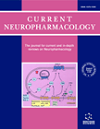- Home
- A-Z Publications
- Current Neuropharmacology
- Previous Issues
- Volume 22, Issue 13, 2024
Current Neuropharmacology - Volume 22, Issue 13, 2024
Volume 22, Issue 13, 2024
-
-
Long-Term Implicit Epigenetic Stress Information in the Enteric Nervous System and its Contribution to Developing and Perpetuating IBS
More LessAuthors: Császár-Nagy Noemi, Petr Bob and István BókkonPsychiatric and mood disorders may play an important role in the development and persistence of irritable bowel syndrome (IBS). Previously, we hypothesized that stress-induced implicit memories may persist throughout life via epigenetic processes in the enteric nervous system (ENS), independent of the central nervous system (CNS). These epigenetic memories in the ENS may contribute to developing and perpetuatin Read More
-
-
-
The Common Denominators of Parkinson's Disease Pathogenesis and Methamphetamine Abuse
More LessAuthors: Bruno Vincent and Mayuri ShuklaThe pervasiveness and mortality associated with methamphetamine abuse have doubled during the past decade, suggesting a possible worldwide substance use crisis. Epitomizing the pathophysiology and toxicology of methamphetamine abuse proclaims severe signs and symptoms of neurotoxic and neurobehavioral manifestations in both humans and animals. Most importantly, chronic use of this drug enhances the pr Read More
-
-
-
Recombinant Antibody Fragments for Neurological Disorders: An Update
More LessAuthors: Karen Manoutcharian and Goar GevorkianRecombinant antibody fragments are promising alternatives to full-length immunoglobulins, creating big opportunities for the pharmaceutical industry. Nowadays, antibody fragments such as antigen-binding fragments (Fab), single-chain fragment variable (scFv), single-domain antibodies (sdAbs), and bispecific antibodies (bsAbs) are being evaluated as diagnostics or therapeutics in preclinical models and in clinical trials. I Read More
-
-
-
Multi-target Phenylpropanoids Against Epilepsy
More LessAuthors: Teresa Carolliny Moreira Lustoza Rodrigues, Arthur L. Dias, Aline M. F. dos Santos, Alex France Messias Monteiro, Mayara Cecile Nascimento Oliveira, Hugo Fernandes Oliveira Pires, Natália Ferreira de Sousa, Mirian Graciela da Silva Stiebbe Salvadori, Marcus Tullius Scotti and Luciana ScottiEpilepsy is a neurological disease with no defined cause, characterized by recurrent epileptic seizures. These occur due to the dysregulation of excitatory and inhibitory neurotransmitters in the central nervous system (CNS). Psychopharmaceuticals have undesirable side effects; many patients require more than one pharmacotherapy to control crises. With this in mind, this work emphasizes the discovery of new substa Read More
-
-
-
Brain Disorder Detection and Diagnosis using Machine Learning and Deep Learning – A Bibliometric Analysis
More LessAuthors: Jyotismita Chaki and Gopikrishna DeshpandeBackground and Objective: Brain disorders are one of the major global mortality issues, and their early detection is crucial for healing. Machine learning, specifically deep learning, is a technology that is increasingly being used to detect and diagnose brain disorders. Our objective is to provide a quantitative bibliometric analysis of the field to inform researchers about trends that can inform their Research directions in th Read More
-
-
-
Astrocytes and Memory: Implications for the Treatment of Memory-related Disorders
More LessAuthors: Juan Wang, Ping Cheng, Yan Qu and Guoqi ZhuMemory refers to the imprint accumulated in the brain by life experiences and represents the basis for humans to engage in advanced psychological activities such as thinking and imagination. Previously, research activities focused on memory have always targeted neurons. However, in addition to neurons, astrocytes are also involved in the encoding, consolidation, and extinction of memory. In particular, ast Read More
-
-
-
Local and Remote Chemogenetic Suppression of Hippocampal Seizures in Rats
More LessAuthors: Donghong Li, Xi Yan, Yue Xing, Jiaqing Yan, Junling Wang, Herui Zhang, Jiaoyang Wang, Xiaonan Li, Zhumin Su, Horace H. Loh, Xiaofeng Yang and Xiaohong ChenBackground: Innovative treatments of refractory epilepsy are widely desired, for which chemogenetic technology can provide region- and cell-type-specific modulation with relative noninvasiveness. Objectives: We aimed to explore the specific applications of chemogenetics for locally and remotely networks controlling hippocampal seizures. Methods: A virus coding for a modified human Gi-coupled M4 muscarinic receptor ( Read More
-
-
-
Effects of Prenatal Methcathinone Exposure on the Neurological Behavior of Adult Offspring
More LessAuthors: Zhang Youyou, Li Zhaoyang, Li Chen, Zhao Shuquan and Wang HuiBackground: Our previous research has shown that prenatal methcathinone exposure affects the neurodevelopment and neurobehavior of adolescent offspring, but the study on whether these findings continue into adulthood is limited. Objective: This study aims to explore the effects of prenatal methcathinone exposure on anxiety-like behavior, learning and memory abilities, as well as serum 5-hydroxytryptamine and do Read More
-
-
-
Glucose Metabolism and Sex Hormones in Male Patients with Medication-naïve First-episode Schizophrenia: A Large-scale Cross-sectional Study
More LessAuthors: Meihong Xiu, Meng Hao, Cai Liu, Maodi Sun and Xiaoe LangBackground: Schizophrenia (SCZ) usually begins in early adult life. The underlying molecular mechanisms of SCZ remain unclear. There is evidence for the involvement of abnormalities in metabolic and endocrine systems in SCZ, even in drug-naïve first-episode schizophrenia patients (DNFES). However, the association between impaired regulation of glucose metabolism and sex hormones was not studied in SCZ. This study aim Read More
-
Volumes & issues
-
Volume 23 (2025)
-
Volume 22 (2024)
-
Volume 21 (2023)
-
Volume 20 (2022)
-
Volume 19 (2021)
-
Volume 18 (2020)
-
Volume 17 (2019)
-
Volume 16 (2018)
-
Volume 15 (2017)
-
Volume 14 (2016)
-
Volume 13 (2015)
-
Volume 12 (2014)
-
Volume 11 (2013)
-
Volume 10 (2012)
-
Volume 9 (2011)
-
Volume 8 (2010)
-
Volume 7 (2009)
-
Volume 6 (2008)
-
Volume 5 (2007)
-
Volume 4 (2006)
-
Volume 3 (2005)
-
Volume 2 (2004)
-
Volume 1 (2003)
Most Read This Month
Article
content/journals/cn
Journal
10
5
false
en


